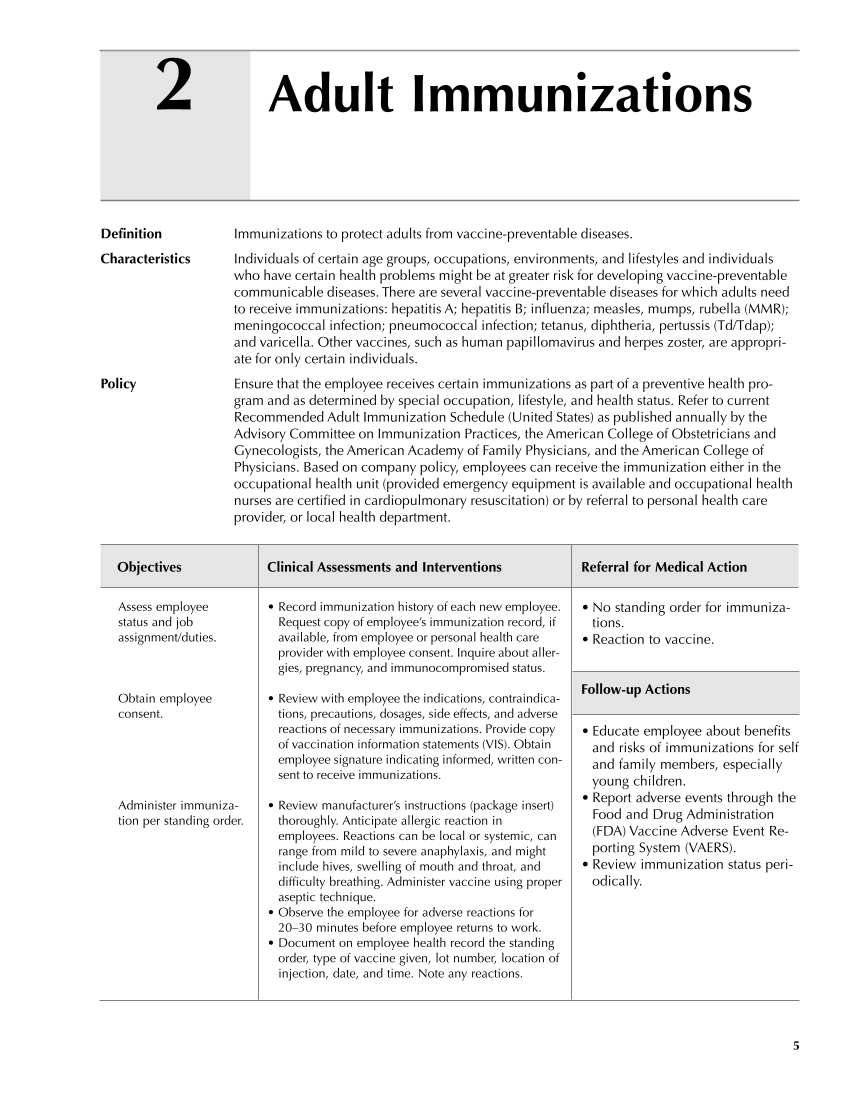Definition Immunizations to protect adults from vaccine-preventable diseases. Characteristics Individuals of certain age groups, occupations, environments, and lifestyles and individuals who have certain health problems might be at greater risk for developing vaccine-preventable communicable diseases. There are several vaccine-preventable diseases for which adults need to receive immunizations: hepatitis A hepatitis B influenza measles, mumps, rubella (MMR) meningococcal infection pneumococcal infection tetanus, diphtheria, pertussis (Td/Tdap) and varicella. Other vaccines, such as human papillomavirus and herpes zoster, are appropri- ate for only certain individuals. Policy Ensure that the employee receives certain immunizations as part of a preventive health pro- gram and as determined by special occupation, lifestyle, and health status. Refer to current Recommended Adult Immunization Schedule (United States) as published annually by the Advisory Committee on Immunization Practices, the American College of Obstetricians and Gynecologists, the American Academy of Family Physicians, and the American College of Physicians. Based on company policy, employees can receive the immunization either in the occupational health unit (provided emergency equipment is available and occupational health nurses are certified in cardiopulmonary resuscitation) or by referral to personal health care provider, or local health department. Objectives Clinical Assessments and Interventions Referral for Medical Action 5 Adult Immunizations 2 • No standing order for immuniza- tions. • Reaction to vaccine. Follow-up Actions • Educate employee about benefits and risks of immunizations for self and family members, especially young children. • Report adverse events through the Food and Drug Administration (FDA) Vaccine Adverse Event Re- porting System (VAERS). • Review immunization status peri- odically. Assess employee status and job assignment/duties. Obtain employee consent. Administer immuniza- tion per standing order. • Record immunization history of each new employee. Request copy of employee’s immunization record, if available, from employee or personal health care provider with employee consent. Inquire about aller- gies, pregnancy, and immunocompromised status. • Review with employee the indications, contraindica- tions, precautions, dosages, side effects, and adverse reactions of necessary immunizations. Provide copy of vaccination information statements (VIS). Obtain employee signature indicating informed, written con- sent to receive immunizations. • Review manufacturer’s instructions (package insert) thoroughly. Anticipate allergic reaction in employees. Reactions can be local or systemic, can range from mild to severe anaphylaxis, and might include hives, swelling of mouth and throat, and difficulty breathing. Administer vaccine using proper aseptic technique. • Observe the employee for adverse reactions for 20–30 minutes before employee returns to work. • Document on employee health record the standing order, type of vaccine given, lot number, location of injection, date, and time. Note any reactions.
Purchased from OEM Press by (ge corporate access). (C) 2013 OEM Health Information, Inc. All rights reserved.












































































































































































































































































































































































































































